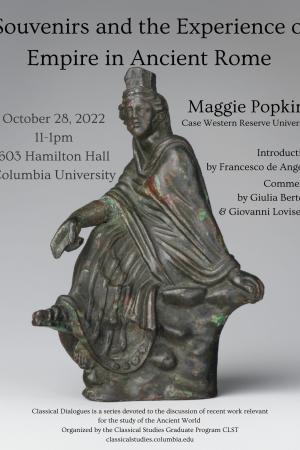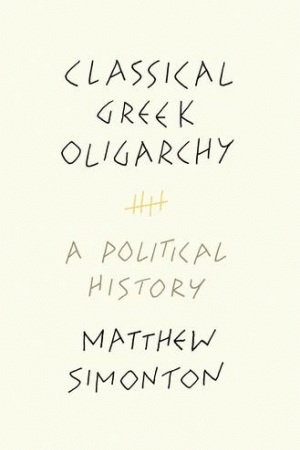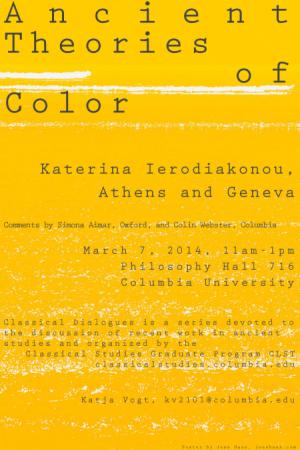As part if its Classical Dialogues series, the Classical Studies Graduate Program CLST at Columbia University is pleased to welcome Professor Katerina Ierodiakonou from the University of Athens and Université de Genève. On March 7, 2014, 11am-1pm, Professor Ierodiakonou will discuss two papers from her research on Ancient Theories of Color, “Aristotle and Alexander of Aphrodisias on the notion of ‘the transparent'” and “The ancient Atomists on the nature and perception of colours.” Comments by Simona Aimar (Oxford) and Colin Webster (Columbia). Location: Philosophy Hall 716, Columbia University. Please see below Professor Ierodiakonou’s abstract.
Ancient views on color have been among the oldest ones discussed in the secondary literature and are among the most contested. There are many perspectives from which scholars have investigated what the ancient Greeks had to say about colors: classical philologists have been interested in the origin and use of Greek color terms; archaeologists have examined the ancient painters’ accounts of the choice and mixing of colors; historians of medicine have studied ancient writings on the anatomy and physiology of the human eye, while historians of science have tried to reconstruct Euclid’s and Ptolemy’s optical theories on the propagation of light. My main interest is in the ancient philosophers’ theories about what exactly makes things colored and how we perceive colors; that is to say, my main interest is in the metaphysics and epistemology of color. The book I am currently working on discusses the views about the nature and perception of color presented by the Presocratics, especially Empedocles and Democritus, by Plato and Aristotle, by the Hellenistic philosophers, by the Aristotelian commentators and by Galen. The questions on which I focus are the following: What is, according to different ancient philosophers, the nature of color? Is it something which characterizes an object independently of whether it is perceived, or is it something which exists only insofar as it is perceived? If it is something which characterizes an object independently of whether it is perceived, what is it precisely that makes an object have the particular color it has? On the other hand, if it is something which exists only insofar as it is perceived, what does actually happen when we perceive a particular color?
In its Classical Dialogues series, the interdepartmental Classical Studies Graduate Program CLST at Columbia University invites authors of recent work in ancient studies that is exemplary for the kind of study that CLST aims to foster. All faculty and students at Columbia and beyond are cordially invited. CLST students are required to read carefully at least one chapter or article in advance and prepare questions and comments for discussion.



































